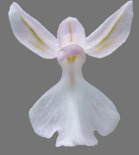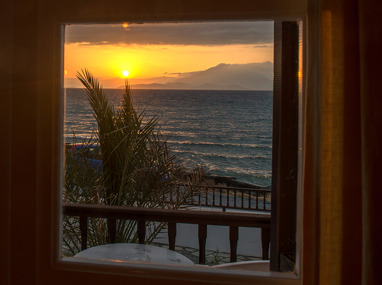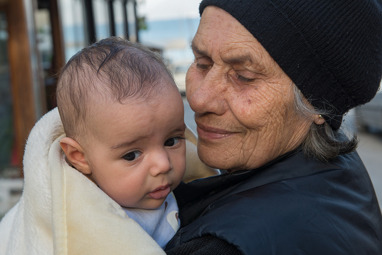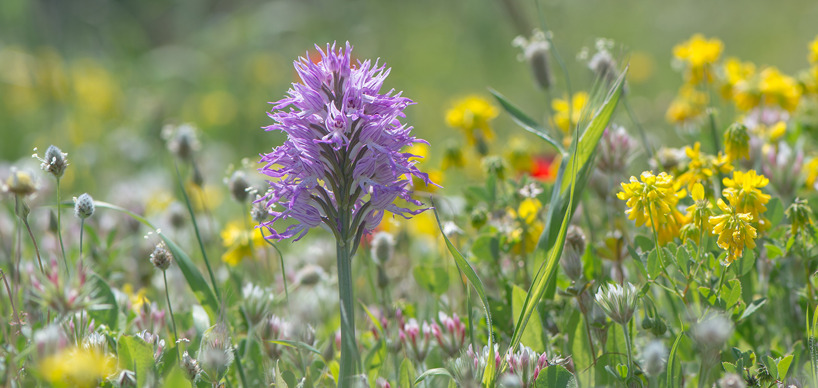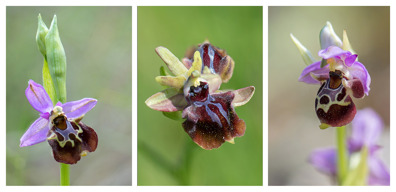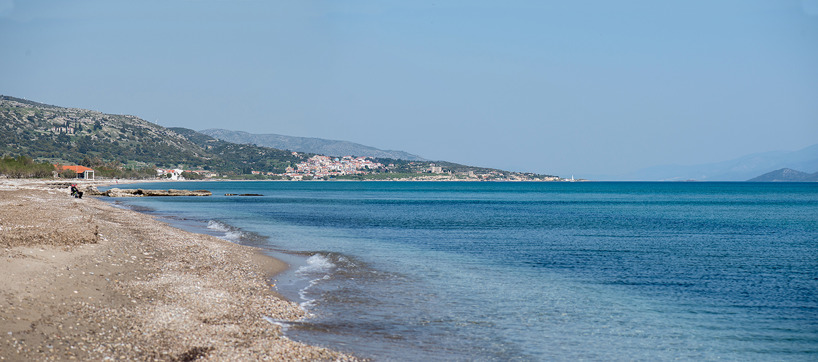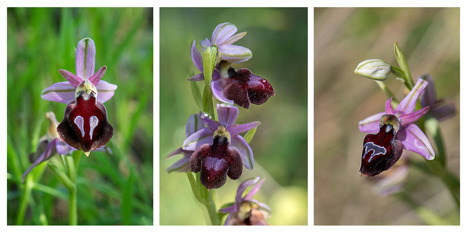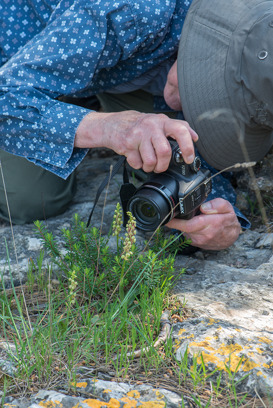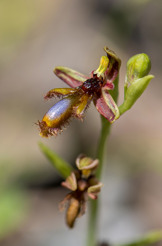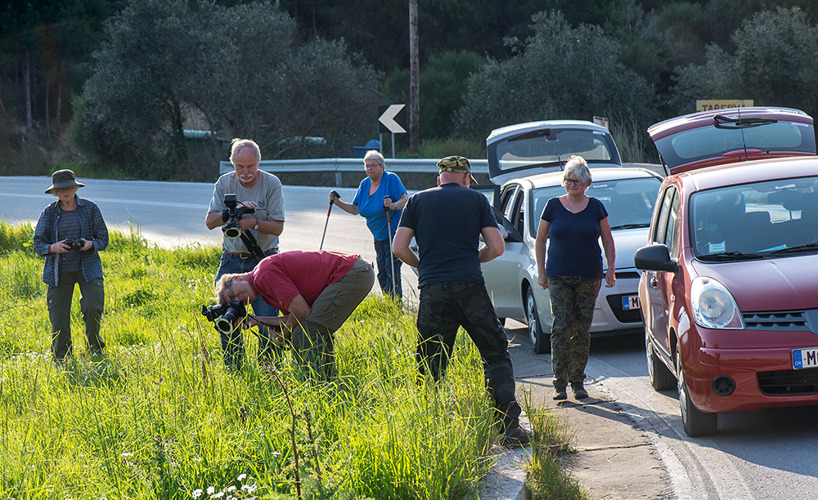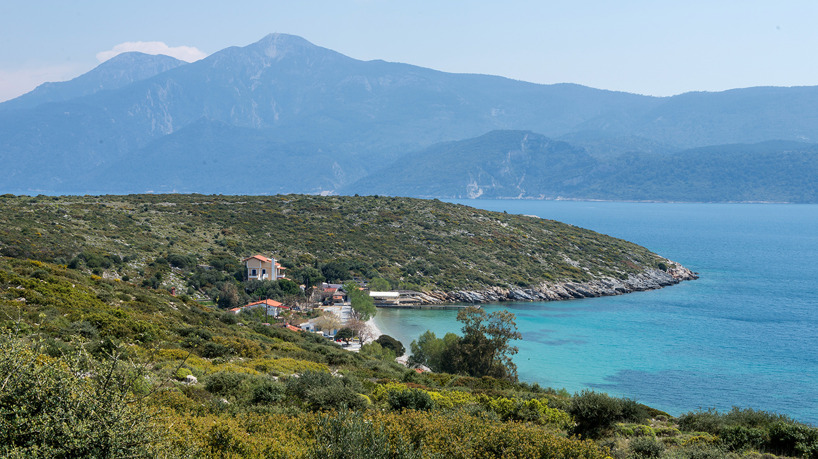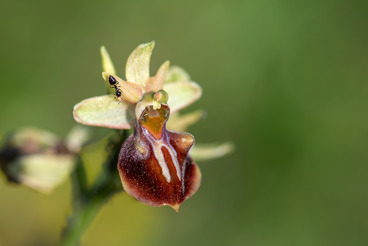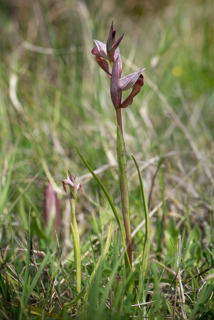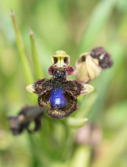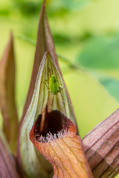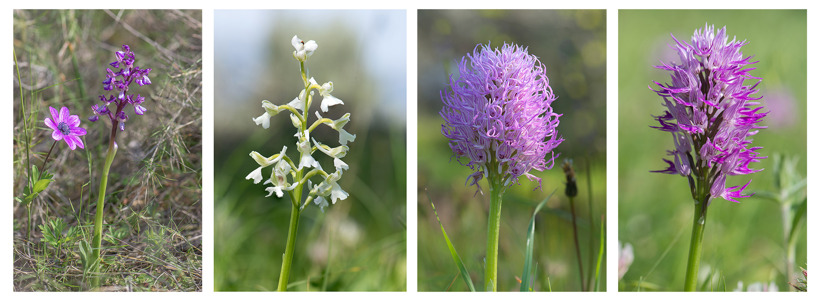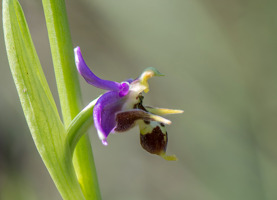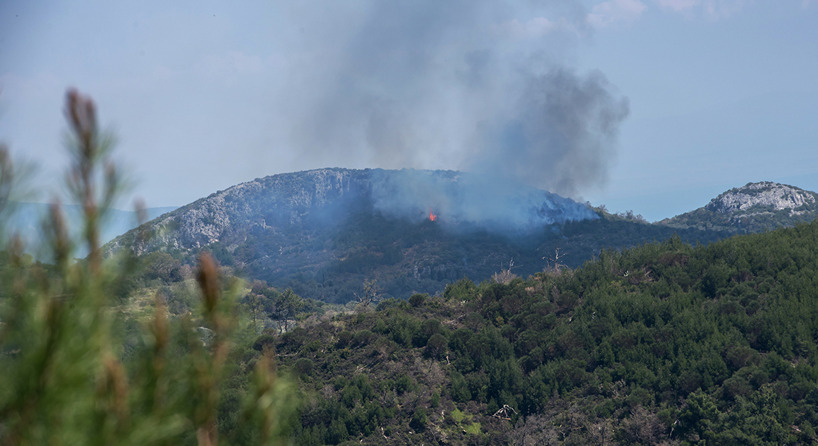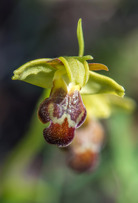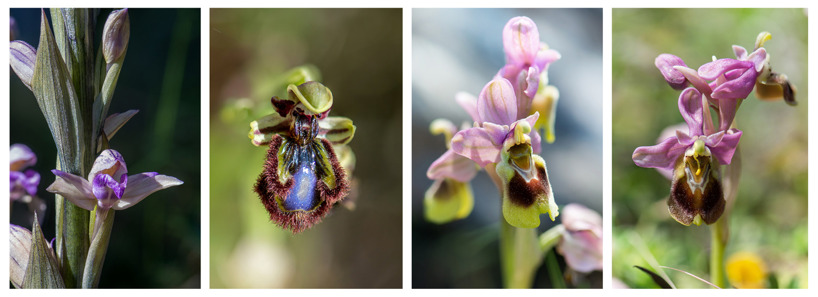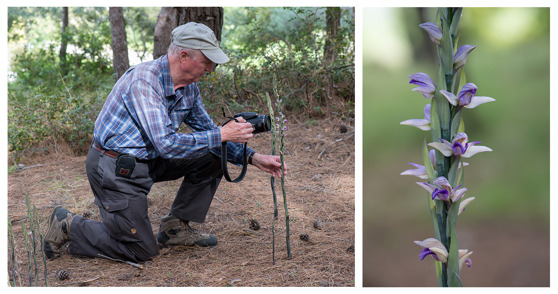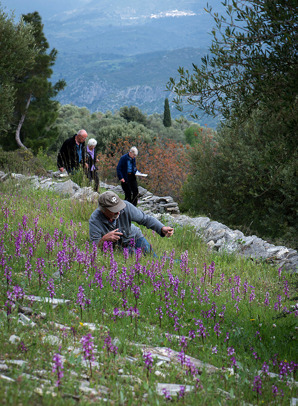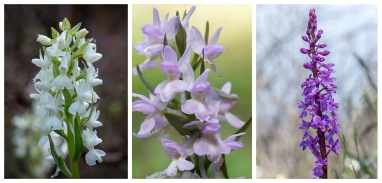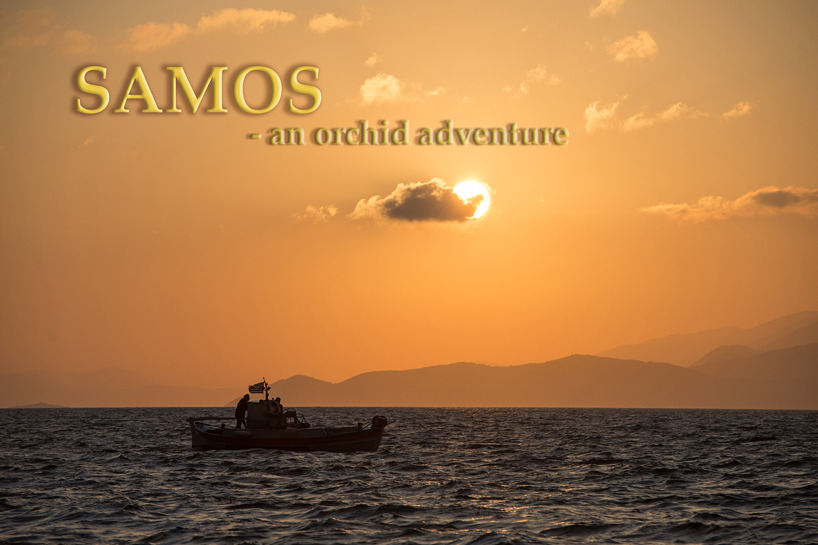
For precise coordinates for sites mentioned below, please contact me using the contact form Home
SAMOS 12-19 April 2015
The 2015 orchid journey is completed, and with a bit of distance, I think that all members in our group still have the feeling of a really nice trip.
We were 13 persons who showed up this April morning at Arlanda, Stockholm, and entered SAS flight to Athens and from there a domestic flight to Samos. This year's trip worked well considering waiting time between flights, both at the outward and return journey, there was almost no such.
Additional four persons joined us later in the evening after having started their journey from Kastrup, Copenhagen. So overall we were 17 persons who now looked forward to the week that we had in front of us.
Small airports are much nicer than these big international with kilometers to walk. At Samos everything was within a comfortable walking distance. So also the car rental, where a nice lady quickly fixed our paper and keys, so that we almost immediately could continue to our hotel.
For this year's base we had chosen "Sunrise Hotel" in the small village Ireon at the south coast just 6 km from the airport. Once there, we felt both proud and VIP when we understand that the hotel had opened just for us and therefore we were the only guests during the week.
It appeared later that the hotel did earn its name. Every morning could, those who manage early mornings, behold a fabulous beautiful sunrise above Turkey on the other side of the strait.
Since it was Easter Sunday in Greece at the time for our arrival, most of the village was “closed”. So also restaurants (the hotel had no restaurant). The hotel hostess, Popi, had therefore arranged for us that a restaurant next door would be open and serve us dinner that evening. A much-appreciated initiative. The restaurant appeared to fill our needs in such a nicely way that we choose this restaurant for dinners rest of the week. But, not least, we choose Restaurant Cohyli (cochlea) because of the friendly restaurant owner (and fishermen), Yannis, and his nice family.
The restaurant owner’s mother and little nephew
The small fishing village, Ireon, became our base for the week. Here a view from the harbor toward Sunrise Hotel
To make it easy we agreed with Popi, the hotel hostess, that each one, at the breakfast, could make himself some sandwiches to take with you as a lunch pack. This worked great.
Already on arrival we were told that we came simultaneously with the warmth this spring. It had been cold and rainy, not only in the winter but also most of the spring. Just some day before we arrived there had been 8 degrees and rain. However, we had a great week with nice Swedish summer weather.
As far as we could judge, the cool and humid winter / spring had not harmed the orchids which were in a quite normal stage. However, we could see that the weather conditions had affected the flowering positive. Rarely had we seen such a mass flowering. Even some Ophrys species occurred, at some sites, in unusual large amounts..
Excursions
Since we arrived at the hotel shortly after noon, we were a few that already in same afternoon, sneaked off to reconnoiter for tomorrow's excursion. And what we saw promised well.
Day 1. Monday 13 April
Orchis italica in a flower filled meadow
For this first day we choose number 1 of the six pre-planned excursions. This meant that we in the morning would botanize in the area just behind the hotel/village, so no car was needed. Still on foot, we continued then westward along a dirt road that went along the steep coastline. Interesting landscape and lot of orchids made it lunchtime before we finally returned to the hotel and our cars that should be used during the afternoon.
During the afternoon we explored the coastal meadows and wetlands inland from the coast northeast of the village. A faint hope of finding Orchis palustris subsp. elegance was not met. The plants we found had some weeks left to flowering which was not surprising in a normal year like this.
We ended the day at a site further inland toward Mili.
Returned to the hotel, we summarized that we this first day had spotted more than 20 species, which maybe was a record.
Site 1 & 2. Behind the hotel
The sites were partly the forest edge toward the bushy area behind the village (hotel) along a dirt road (1). Partly the area along the dirt road toward Papa Beach west of the village (2).
N= new species for this journey
Orchids
Anacamptis papilionacea faded......N
Limodorum abortivum bud .............N
Ophrys ferrum equinum...................N
Ophrys homeri.................................N
Ophrys iricolor..................................N
Ophrys parosica ..............................N
Ophrys pelinaea...............................N
Ophrys samiotissa............................N
Ophrys sicula....................................N
Ophrys sitiaca...................................N
Ophrys speculum..............................N
Ophrys umbilicata..............................N
Orchis anatolica.................................N
Serapias bergonii...............................N
Serapias orientalis subsp. carica.. ....N
Serapias parviflora.............................N
Serapias vomeracea..........................N
Site 3. Inland the beach east of Ireon
The area behind the beach east of Ireon. Grassy dunes and wetlands inland from the cost
Orchids
Anacamptis palustris subsp. elegans, leaves.N
Ophrys bombyliflora........................................N
Ophrys ferrum equinum
Ophrys mammosa..........................................N
Orchis italica............................................... ...N
Serapias bergonii
Site 5 (according map) 3.5 km from Ireon, terrace-like slope
Since we chose a different rout, than the planned according our map, we came from behind to the next site, number 5 at the map. This become also the last one for the day since we chose to skip number 4.
Orchids
Anacamptis morio subsp. caucasica......N
Anacamptis papilionacea, faded
Ophrys parosica
Ophrys pelinaea
Ophrys sicula
Orchis italica
Day 2. Tuesday 14 April
Route four, that were chosen for this day, was the longest of all pre-planned excursions, just over 80 km. The advantage of the island's size, about 4.5 x 2.5 mil, was that the daily excursions couldn't be too long. But even if the numbers of kilometers couldn't be that high, it took time. The roads on the island were not among the best; therefore the average speed was quite low. We chose to start with the site that was farthest away. From that area there were very many orchids listed and we didn't want to risk not cope with them. And that was a good idea for the area was found to meet the expectations of both the number of species and number of flowering plants. We picked up the other sites as we approached Ireon again. However, we chose to skip site one, in order to get home in time for tonight's dinner.
Orchis anatolica
Three different variants of Ophrys ferrum-equinum. Left: subsp. labiosa, middle: var. subtriloba and to the right a variant that reminds of Ophrys gottfrediana from the Greek western islands
Site 7 & 8. Area along the dirt road
Dirt road south of the turnoff to Paleochori. Scrubby slopes on both sides of the road.
Orchids
Anacamptis morio subsp. caucascia
Anacamptis pyramidalis...........................N
Ophrys ferrum-equinum
Ophrys iricolor
Ophrys minutula? ...................................N
Ophrys parosica
Ophrys sicula
Ophrys villosa..........................................N
Ophrys umbilicata
Orchis anatolica
Serapias orientalis subsp. carica
Site 6. Lunch at the chapel
Back at the main road we choose to take lunch at a small chapel next to the road cross where the Paleochori-road took off from the main road. The site is the area to the left side of the road.
Orchids
Anacamptis morio subsp. caucasica
Limodorum abortivum
Orchis anatolica
Orchis anthropophora...................................N
Orchis italica
Site 5. Agia Kyriaki II
Slopes at both sides of the road.
Orchids
Limodorum abortivum
Ophrys blitopertha...................................N
Ophrys ceto ??........................................N
Ophrys iricolor.
Ophrys regis-ferdinandii……………..……N
Ophrys samiotissa
Ophrys sicula
Ophrys umbilicata
Site 3. Limnionas
Olive groves at dirt road.
Orchids
Anacamptis fragrans
Anacamptis pyramidalis
Anacamptis sancta
Limodorum abortivum
Ophrys blitopertha
Ophrys ferrum-equinum
Ophrys iricolor
Ophrys parosica
Ophrys regis-ferdinandii
Ophrys sicula
Orchis italica
Serapias bergonii
Lokal 2. Votsalakia II
Grassy slopes.
Orchids
Ophrys ferrum-equinum
Ophrys iricolor
Ophrys mammosa
Ophrys minutula?
Ophrys parosica
Ophrys phrygane ……................……..N
Ophrys samiotissa
Ophrys sicula
Ophrys umbilicata
Orchis italica
Serapias orientalis subsp. carica
Day 3. Wednesday 15 April
Today's excursion, Route 5, was mainly along the east coast to the southeastern tip of the island. The last part of the road was a dirt road, we knew, but perhaps not how bad the condition was. But that we became aware of. During the week, we learned that you should stay away from gravel roads if you only had an ordinary car. The heavy raining during the winter / spring had placed a large part of such roads in a very poor condition. But the impression of the bad road was offset by the beautiful views we could enjoy along the coast. Here the narrow Mycale Strait, with Turkey on the other side, was at the narrowest point about 1.2 km.
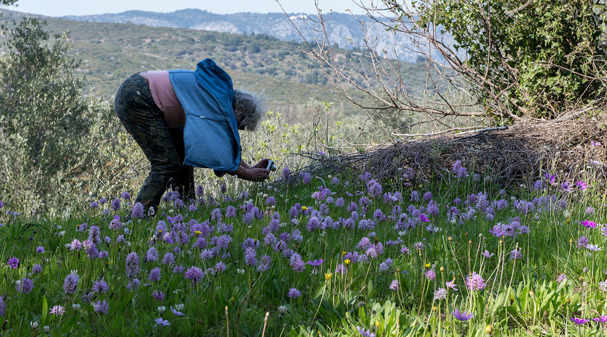
Some orchids, especially Anacamptis- and Orchis-species, are visible from a long distance and are therefore excellent markers for areas to be searched for other species. Such a site we found on our way back home. In an old olive grove below the road several thousand of Orchis italica where flowering. An absolutely fabulous view for an orchid enthusiast!.
Site 1. Road to Psili Ammos I
After passing Pythagorion we turned right towards Psili Ammos and continue about 1.5 km from the junction. The site was about 300 meters further down a dirt road to the right. Quite dry marsh
Orchids
Ophrys apifera...................................... N
Ophrys bombyliflora
Serapias bergonii
Serapias orientalis subsp. carica
Serapias parviflora
Serapias vomeracea
Site 2. Road to Psili Ammos II
About 1.1 km from site 1, towards Psili Ammos, in a slight left hand curve a path goes to the right towards Mykli Beach. The site was the area along this road.
Orchids
Ophrys ferrum-equinum
Ophrys mammosa
Ophrys sicula
Orchis italica
Serapias orientalis subsp. carica
Serapias vomeracea
Site 3. Road to Psili Ammos III,
A couple of 100-meters from site 2 we turned right, still toward Psili Ammon. Site 3 further on about 250 m. Roadsides and terraces with olive trees.
Orchids
Anacamptis morio subsp. caucasica
Himantoglossum robertianum, faded
Ophrys mammosa
Orchis italica
Serapias orientalis subsp. orientalis
Serapias orientalis subsp. carica.
Serapias vomeracea
Site 3. At the lake
Further on about 1.4 km there is a small lake. To the left there is an old sport ground. Large open areas. Most orchids at the left side of the road that goes around the lake.
Orchids
Ophrys bombyliflora, lot of
Ophrys oestrifera/fuciflora sp. hybrid?
Serapias orientalis subsp. orientalis
Serapias parviflora
Serapias vomeracea
Serapias orientalis subsp. carica.
Site 5. Dry slope to the left
About 400 m further on along the road that goes around the lake.
Orchids
Ophrys speculum subsp. orientalis
Orchis italica
Serapias orientalis subsp. carica.

Site 6. Klima I.
From site 5 we passed the lake and later the village Psili Ammon. From here there is only a dirt road further east (at the time for our visit in a very bad condition). The road follows the coastline eastward. Site 6 was about 3.3 km from Site 5. Slopes to the left with olive and shrubs.
Site 7. Klima II
Area with costal phrygana just after the village Klima, 2.2 km from site 6. Dry area covered by cistus and other low growing shrubs. This area seems to be too dry at the time for our visit.
Orchids
Anacamptis sancta, (bud)
Site 8. Possidonio
Passed the village Possidonio we turned left about 1 km after the village. Terraces and olive groves.
Orchids
Anacamptis morio subsp. caucasica
Himantoglossum robertianum, faded
Ophrys mammosa, faded
Ophrys sicula
Serapias orientalis subsp. carica
Serapias orientalis subsp. orientalis...............N
Not planned stop at a church.
On our way back home, we once again did a not planned stop. Below the road there were terraces with some old olive trees and below these Orchis italica in hundreds perhaps thousands, a fabulous sight for us orchid enthusiasts. Above the road there was a small church, and here were also orchids. Among others here we found this journey’s only "typical" Ophrys cerastes.
Day 4. Thursday 16 April
This was a day when we experiencde that one should keep away from small gravel roads. The plan was to follow Route 3 that went around Ambelos, the 1153 m high mountain in the middle of the island. It soon turned out that the planned route has to go on small gravel roads which made us hesitant, but after some discussion we decided to make an attempt. Already after about 3 km we had to give up and turn back again. Perhaps it would have been possible to go on with a 4-wheel drive jeep. A man from the village nearby told us that because the condition of the road after the winter rain it was not possible to go further with cars like ours.
Anyhow we were not without neither orchids nor news for the journey. We found several interesting sites on the way back. But first we decided that we would return to the main road and a place that usually was used for honey sales, which now stood empty, a few kilometers away and there take our lunch.
Satisfied after our lunch we drove back and up that bad road again. I wonder what they were thinking in the car that we earlier met on our way down and now we met again. Maybe: "Didn't they learn anything the first time?" But this time we didn't go that far but stayed on the part of the road that was passable and explored the sites that we earlier saw on our way down.
Site 1. About 3 km from main road
About 2 km from Pirgos a graveled road turned right (near a military area). After about 3 km we had to turn back. Bushy area.
Orchids
Himantoglossum robertianum
Ophrys heterochila (dodecanensis)….............N
Site 2. Area for honey sales
Back at the main road we continued 1 km westward to an area for honey sales where we took our lunch. The site here is a shrubby area on the other side of the main road.
Orchids
Ophrys mammosa
Ophrys parosica
Ophrys pelinaea
Ophrys sicula
Orchis anatolica
Orchis italica
Site 3. Back on the bad road
A short stop at about 2 - 2.5 km up on the gravel road. Scrubby area. On our earlier way down some of us had noticed an Ophrys with very big flowers. Now we would take a closer look. It reminds about Ophrys samiotissa but this one was much bigger. Could this be an Ophrys samia? Probably not since O. samia is flowering somewhat later.
Orchids
Ophrys samia??
Site 4. 1 km from the main road
Once again we turned back but now we did a stop about 1 km from the main road. Wide area partly grassy partly bushy on both side of the road. Lots of Ophrys mammosa, hundreds.
Orchids
Dactylorhiza romana..................N
Neotinea maculata………………N
Ophrys herae
Ophrys iricolor
Ophrys mammosa
Ophrys minutula?
Ophrys samiotissa
Ophrys sicula
Ophrys heterochila
Orchis anatolica
Site 5. Anemone pavonina
Day 5. Friday 17 April
We had now reached the second last of our excursion days and for the day we chose the pre-planned route no. 6, which once again went eastward, but this time further north, partly along the north coast which once again gave breathtaking views.
But we started the day with a site just east of Paleokastro. We then went north and checked the sites 2 and 3 but skipped 4th which not seemed to be any orchid site anymore. Site 5 was the area close to the big monastery Moni Zoodochou and here we also took our lunch before we continued towards the north coast.
At our continued journey we missed the plotted road on the map. This was probably one of those small dirt roads that we should avoid. Therefore, we came toward sites 6-8 from the west after a drive along the north coast with beautiful views. Site 6 was completely overgrown so we choose to botanize at sites 7 and 8 before we set course back home.
Site 1. Paleokastro
This site was a couple of 100-meters down at a dirt-road to the right just after passing the village.
Orchids
Anacamptis sancta (maybe coriophora), bud
Himantoglossum robertianum, faded
Limodorum abortivum
Ophrys ferrum-equinum
Ophrys mammosa
Ophrys sicula
Ophrys umbilicata
Orchis italica
Site 2. Tirada I
Shortly after site 1 we turned left toward Tirada/Zoni. About 700 m from this left hand turn, in a rather sharp left curve there are terraces with olive trees.
Orchids
Anacamptis morio subsp. caucasica
Anacamptis pyramidalis
Anacamptis sancta (or coriophora), bud
Himantoglossum robertianum, faded
Ophrys ferrum-equinum
Ophrys mammosa
Orchis italica
Serapias orientalis subsp. carica
Site 3. Tirada II
Further on about 400 m there is a nice grove.
Orchids
Anacamptis morio subsp. caucasica
Himantoglossum robertianum
Ophrys ferrum-equinum
Ophrys mammosa
Ophrys parosica
Ophrys sicula
Ophrys speculum subsp. orientalis
Ophrys leochroma.................................N
Ophrys umbilicata
Orchis italica
Serapias bergonii
Serapias vomeracea (big specimen)
Site 5. Monastery Moni Zoodochou Pigi
The area at site 4 at our map doesn’t look suitable for orchid so we just passed by. Site 5 is the area just outside the monastery. Stony slopes with some bushes.
Orchids
Anacamptis morio subsp. caucasica
Neotinea maculata
Ophrys bombyliflora
Ophrys ferrum-equinum
Ophrys heterochila
Ophrys minutula?
Ophrys sicula
Ophrys umbilicata
Orchis anatolica
Site 7. Galatzio II.
Since we missed the narrow road northward just after living the monastery, we drove further west to Samos town and from there followed the north coast to sites 6-8. Site 6 was totally overgrown so vi started with site 7 according our map. Slopes with grassy phrygana on both sides of the road.
Orchids
Anacamptis morio subsp. caucasica
Anacamptis morio subsp. caucasica var. alba
Anacamptis pyramidalis
Limodorum abortivum
Neotinea maculata
Ophrys ferrum-equinum
Ophrys parosica
Ophrys pelinaea
Ophrys sicula
Ophrys sitiaca
Ophrys umbilicata
Orchis anatolica
Site 8. Ag. Paraskevi
We continued downhill toward the small village Ag. Paraskevi. Site 8 was a grassy/schrubby area just before we entered the willage. No good orchid area.
Orchids
Ophrys ferrum-equinum
Ophrys sicula
Ophrys speculum
Serapias orientalis subsp. carica
Day 6. Saturday 18 April
This last day we would stay in the neighborhood of Ireon according Route 2. This was the one that was left. We set course for the villages Pagondas and Spatharei few kilometers west of Ireon to explore the area between them.
Our first site (sites 1 and 2) was found to be, addition to be species rich, the most magnificent area we saw during our journey. Along a narrow road there was terraced hillside with sparse, old olive trees. The terraces were full of thousands Orchis anatolica and all was at their height of flowering. A magnificent sight that none of us had seen before.
Even today's last site offered surprises. Here, in an area of old farming landscape, now more or less overgrown, we found two more news for the trip. The first one was Orchis mascula subsp. pinetorum, a close relative to the well-known Orchis mascula and the second was Cephalanthera longifolia, a species known from home. This was the only one of all species we saw which can be found back home.
The plan was that we should be home early this day, to start packing for the trip home the next morning. Anyhow, some of us still managed to take a trip to the area above the hotel, where we the first day had found Limodorum abortivum with buds, to check if it had start flowering during the week. And yes it had!
Site 1 & 2. Pagondas I & II
After passing Pagondas toward Spatharei at about 1,7 km there is a narrow dirt road to the left.
Pine forest to the left of the main road with many Ophrys fusca sp. Site 2 was the area along the dirt road to the left. Terraces with old olive trees, a stunning hillside filled with Orchis anatolica och Anemone pavonina.
Orchids
Himantoglossum robertianum
Neotinea maculata
Ophrys iricolor
Ophrys mammosa
Ophrys parosica
Ophrys pelinaea
Ophris samiotissa
Ophrys sicula
Ophrys sitiaca
Ophrys umbilicata
Orchis anatolica
Orchis atropophorum
Orchis italica
Serapias bergoni
Site 3. Pagondas III
After about 750 m further on the main road there is a green area with tall cypress trees and scattered olive trees.
Orchids
Anacamptis morio subsp. caucasica
Ophrys homeri ??
Ophrys iricolor
Ophrys sicula
Orchis anatolica
Orchis italica
Site 6. Spatharei football field
Local 4 o 5 looked inaccessible so we chose to drive on to site 6.
Site 6 was an area just above the football field outside Spatharei. The area was probably former cultivated land; some terraces were almost total overgrown. Here we finally found Orchis mascula subsp. pinetorum that we thought we would miss because we couldn't get up towards Ampeliko.
This was our last site for the day and also for this journey.
Orchids
Anacamptis morio subsp. caucasica
Cephalantera longifolia..........................N
Dactylorhiza romana (white and red)
Limodorum abortivum
Ophrys samiotissa
Ophrys umbilicata
Orchis mascula subsp. pinetorum.............N
Three species from our last site. From left Dactylorhiza romana,
white and a delicate pink form. The last one is Orchis mascula
subsp. pinetorum.
A very happy team after a wonderful week on this beautiful island. Samos is an island I strongly can recommend either you are out for orchids or just a relaxing holiday
The trip had surpassed everyone's expectations both regarding the weather, our accommodations at Sunrise Hotel and not least the amount of species found. Subject to some uncertainty species we had noted over 40 species. Only three species were not seen flowering. Anacamptis papilionacea subsp. heroica, already wilted, Anacamptis sancta and Anacamptis palustris subsp. elegans only seen with buds.
Comments
Quite clearly the wet autumn, winter and spring had affected the orchids positive. Traveling in the eastern Mediterranean you often see many species, but usually few plants of each. At Samos most species we saw were in large numbers. Even within Ophrys the amount of plants was surprisingly high in many areas.
There were several other species that should have been possible to find, for example Orchis simia but this is very local and in an area that we didn’t visit. The same is for Ophrys reinholdii. Neotinea tridentata should also have been possible to find but it is slightly later and possibly not in flower during our visit. Orchis provincialis is also flowering in April, but in higher-lying areas, areas that we didn’t reached due the bad road standard. Another Ophrys species which we had expected to see was Ophrys cinereophila, but even if we were around in the right areas we didn’t find it.
The most common species seen during our visit was Ophrys sicula, it was seen at almost all visited the sites. A discussion took place on whether we found the related Ophrys phryganae or not, but at least one plant seen was this species. Other doubtful species were:
Ophrys samia, usually flowering later in April and May and the lip form did not match properly with O. Samia.
Ophrys cerastes subsp. minuscula, few plants were seen that in size could be this species, but it must be considered doubtful (probibly Ophrys minutula).
Ophrys homeri, uncertainty about what we saw remains. It’s possibly the findings should be called Ophrys oreas but this species isn’t earlier mentioned from Samos. Perhaps it should be included in O. samiotissa, a species that seems to be very multiform.
I have to say that for an amateur it is almost impossible to sort out the Ophrys oestrifera-group in the eastern Mediterranean, if it is even possible for the experts.
Even the Ophrys fusca-group is difficult. Being there we thought that we found a lot of Ophrys leucadica but well at home and careful studying the pictures I have to count some of those as O. pelinaea.
Species found:
Anacamptis coriophora subsp. coriophora
Anacamptis morio subsp. caucasica
Anacamptis palustris subsp. elegans, rosettes
Anacamptis papilionacea subsp. heroica, only faded plants
Anacamptis pyramidalis (var. bracystachys is the only form at Samos)
Anacamptis sancta, only buds
Cephalanthera longifolia
Dactylorhiza romana, white and red form
Himantoglossum robertianum
Limodorum abortivum
Neotinea maculata, white form
Orchis anatolica
Orchis anthropophorum
Orchis italica
Orchis mascula subsp. pinetorum
Serapias bergonii
Serapias orientalis subsp. carica
Serapias orientalis subsp. orientalis
Serapias parviflora
Serapias vomeracea
PSEUDOPHRYS
Ophrys blitopertha
Ophrys iricolor
Ophrys parosica var. parosica
Ophrys pelinaea
Ophrys phryganae
Ophrys sicula
Ophrys sitiaca
EUOPHRYS
Ophrys apifera
Ophrys bombyliflora
Ophrys cerastes var. cerastes
Ophrys ceto, unsure
Ophrys ferrum-equinum var. ferrum-equinum
Ophrys ferrum-equinum var. labiosa
Ophrys ferrum-equinum var. triloba
Ophrys herae
Ophrys heterochila (syn. O. dodecanensis)
Ophrys homeri, could be Ophrys oreas (or O. samiotissa?)
Ophrys leochroma
Ophrys mammosa
Ophrys minutula, unsure, most of the flowers we saw had taller lip than what is usual at O. minutula.
Ophrys regis-ferdinandii
Ophrys samia, probable not, possibly O. samiotissa with unusual tall lip
Ophrys samiotissa
Ophrys speculum var. orientalis
Ophrys umbilicata
Ophrys villosa
In total the list above gives 46 taxon unsure species included.
Thanks
